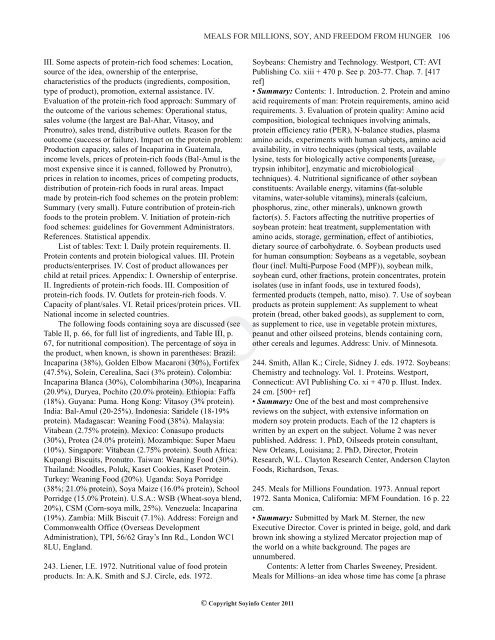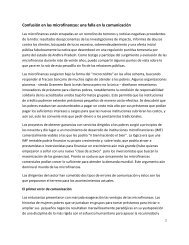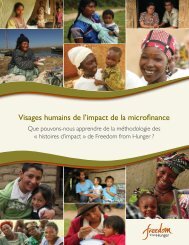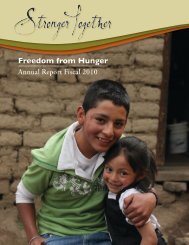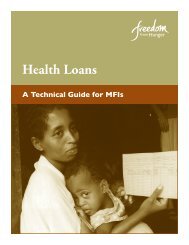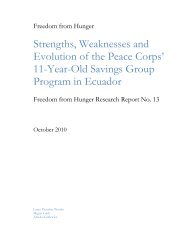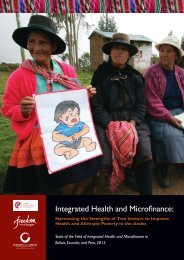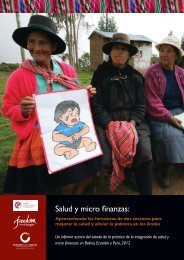history of meals for millions, soy, and freedom from ... - SoyInfo Center
history of meals for millions, soy, and freedom from ... - SoyInfo Center
history of meals for millions, soy, and freedom from ... - SoyInfo Center
Create successful ePaper yourself
Turn your PDF publications into a flip-book with our unique Google optimized e-Paper software.
III. Some aspects <strong>of</strong> protein-rich food schemes: Location,<br />
source <strong>of</strong> the idea, ownership <strong>of</strong> the enterprise,<br />
characteristics <strong>of</strong> the products (ingredients, composition,<br />
type <strong>of</strong> product), promotion, external assistance. IV.<br />
Evaluation <strong>of</strong> the protein-rich food approach: Summary <strong>of</strong><br />
the outcome <strong>of</strong> the various schemes: Operational status,<br />
sales volume (the largest are Bal-Ahar, Vita<strong>soy</strong>, <strong>and</strong><br />
Pronutro), sales trend, distributive outlets. Reason <strong>for</strong> the<br />
outcome (success or failure). Impact on the protein problem:<br />
Production capacity, sales <strong>of</strong> Incaparina in Guatemala,<br />
income levels, prices <strong>of</strong> protein-rich foods (Bal-Amul is the<br />
most expensive since it is canned, followed by Pronutro),<br />
prices in relation to incomes, prices <strong>of</strong> competing products,<br />
distribution <strong>of</strong> protein-rich foods in rural areas. Impact<br />
made by protein-rich food schemes on the protein problem:<br />
Summary (very small). Future contribution <strong>of</strong> protein-rich<br />
foods to the protein problem. V. Initiation <strong>of</strong> protein-rich<br />
food schemes: guidelines <strong>for</strong> Government Administrators.<br />
References. Statistical appendix.<br />
List <strong>of</strong> tables: Text: I. Daily protein requirements. II.<br />
Protein contents <strong>and</strong> protein biological values. III. Protein<br />
products/enterprises. IV. Cost <strong>of</strong> product allowances per<br />
child at retail prices. Appendix: I. Ownership <strong>of</strong> enterprise.<br />
II. Ingredients <strong>of</strong> protein-rich foods. III. Composition <strong>of</strong><br />
protein-rich foods. IV. Outlets <strong>for</strong> protein-rich foods. V.<br />
Capacity <strong>of</strong> plant/sales. VI. Retail prices/protein prices. VII.<br />
National income in selected countries.<br />
The following foods containing <strong>soy</strong>a are discussed (see<br />
Table II, p. 66, <strong>for</strong> full list <strong>of</strong> ingredients, <strong>and</strong> Table III, p.<br />
67, <strong>for</strong> nutritional composition). The percentage <strong>of</strong> <strong>soy</strong>a in<br />
the product, when known, is shown in parentheses: Brazil:<br />
Incaparina (38%), Golden Elbow Macaroni (30%), Fortifex<br />
(47.5%), Solein, Cerealina, Saci (3% protein). Colombia:<br />
Incaparina Blanca (30%), Colombiharina (30%), Incaparina<br />
(20.9%), Duryea, Pochito (20.0% protein). Ethiopia: Faffa<br />
(18%). Guyana: Puma. Hong Kong: Vita<strong>soy</strong> (3% protein).<br />
India: Bal-Amul (20-25%). Indonesia: Saridele (18-19%<br />
protein). Madagascar: Weaning Food (38%). Malaysia:<br />
Vitabean (2.75% protein). Mexico: Conasupo products<br />
(30%), Protea (24.0% protein). Mozambique: Super Maeu<br />
(10%). Singapore: Vitabean (2.75% protein). South Africa:<br />
Kupangi Biscuits, Pronutro. Taiwan: Weaning Food (30%).<br />
Thail<strong>and</strong>: Noodles, Poluk, Kaset Cookies, Kaset Protein.<br />
Turkey: Weaning Food (20%). Ug<strong>and</strong>a: Soya Porridge<br />
(38%; 21.0% protein), Soya Maize (16.0% protein), School<br />
Porridge (15.0% Protein). U.S.A.: WSB (Wheat-<strong>soy</strong>a blend,<br />
20%), CSM (Corn-<strong>soy</strong>a milk, 25%). Venezuela: Incaparina<br />
(19%). Zambia: Milk Biscuit (7.1%). Address: Foreign <strong>and</strong><br />
Commonwealth Office (Overseas Development<br />
Administration), TPI, 56/62 Gray’s Inn Rd., London WC1<br />
8LU, Engl<strong>and</strong>.<br />
243. Liener, I.E. 1972. Nutritional value <strong>of</strong> food protein<br />
products. In: A.K. Smith <strong>and</strong> S.J. Circle, eds. 1972.<br />
MEALS FOR MILLIONS, SOY, AND FREEDOM FROM HUNGER 106<br />
© Copyright Soyinfo <strong>Center</strong> 2011<br />
Soybeans: Chemistry <strong>and</strong> Technology. Westport, CT: AVI<br />
Publishing Co. xiii + 470 p. See p. 203-77. Chap. 7. [417<br />
ref]<br />
• Summary: Contents: 1. Introduction. 2. Protein <strong>and</strong> amino<br />
acid requirements <strong>of</strong> man: Protein requirements, amino acid<br />
requirements. 3. Evaluation <strong>of</strong> protein quality: Amino acid<br />
composition, biological techniques involving animals,<br />
protein efficiency ratio (PER), N-balance studies, plasma<br />
amino acids, experiments with human subjects, amino acid<br />
availability, in vitro techniques (physical tests, available<br />
lysine, tests <strong>for</strong> biologically active components [urease,<br />
trypsin inhibitor], enzymatic <strong>and</strong> microbiological<br />
techniques). 4. Nutritional significance <strong>of</strong> other <strong>soy</strong>bean<br />
constituents: Available energy, vitamins (fat-soluble<br />
vitamins, water-soluble vitamins), minerals (calcium,<br />
phosphorus, zinc, other minerals), unknown growth<br />
factor(s). 5. Factors affecting the nutritive properties <strong>of</strong><br />
<strong>soy</strong>bean protein: heat treatment, supplementation with<br />
amino acids, storage, germination, effect <strong>of</strong> antibiotics,<br />
dietary source <strong>of</strong> carbohydrate. 6. Soybean products used<br />
<strong>for</strong> human consumption: Soybeans as a vegetable, <strong>soy</strong>bean<br />
flour (incl. Multi-Purpose Food (MPF)), <strong>soy</strong>bean milk,<br />
<strong>soy</strong>bean curd, other fractions, protein concentrates, protein<br />
isolates (use in infant foods, use in textured foods),<br />
fermented products (tempeh, natto, miso). 7. Use <strong>of</strong> <strong>soy</strong>bean<br />
products as protein supplement: As supplement to wheat<br />
protein (bread, other baked goods), as supplement to corn,<br />
as supplement to rice, use in vegetable protein mixtures,<br />
peanut <strong>and</strong> other oilseed proteins, blends containing corn,<br />
other cereals <strong>and</strong> legumes. Address: Univ. <strong>of</strong> Minnesota.<br />
244. Smith, Allan K.; Circle, Sidney J. eds. 1972. Soybeans:<br />
Chemistry <strong>and</strong> technology. Vol. 1. Proteins. Westport,<br />
Connecticut: AVI Publishing Co. xi + 470 p. Illust. Index.<br />
24 cm. [500+ ref]<br />
• Summary: One <strong>of</strong> the best <strong>and</strong> most comprehensive<br />
reviews on the subject, with extensive in<strong>for</strong>mation on<br />
modern <strong>soy</strong> protein products. Each <strong>of</strong> the 12 chapters is<br />
written by an expert on the subject. Volume 2 was never<br />
published. Address: 1. PhD, Oilseeds protein consultant,<br />
New Orleans, Louisiana; 2. PhD, Director, Protein<br />
Research, W.L. Clayton Research <strong>Center</strong>, Anderson Clayton<br />
Foods, Richardson, Texas.<br />
245. Meals <strong>for</strong> Millions Foundation. 1973. Annual report<br />
1972. Santa Monica, Cali<strong>for</strong>nia: MFM Foundation. 16 p. 22<br />
cm.<br />
• Summary: Submitted by Mark M. Sterner, the new<br />
Executive Director. Cover is printed in beige, gold, <strong>and</strong> dark<br />
brown ink showing a stylized Mercator projection map <strong>of</strong><br />
the world on a white background. The pages are<br />
unnumbered.<br />
Contents: A letter <strong>from</strong> Charles Sweeney, President.<br />
Meals <strong>for</strong> Millions–an idea whose time has come [a phrase


